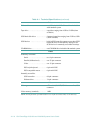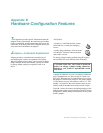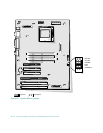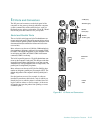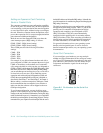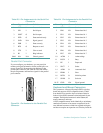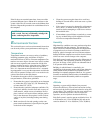
B-126 Dell PowerEdge 2100/180 and 2100/200 Systems User’s Guide
Adding an Expansion Card Containing
Serial or Parallel Ports
The computer system has an autoconfiguration capability
for the serial ports. This feature lets you add an expansion
card containing a serial port that has the same designation
as one of the built-in ports, without having to reconfigure
the card. When the computer detects the duplicate serial
port on the expansion card, it remaps (reassigns) the built-in
port to the next available port designation.
Both the new and the remapped COM ports share the
same interrupt request (IRQ) setting, as follows:
COM1, COM3: IRQ4 (shared setting)
COM2, COM4: IRQ3 (shared setting)
These COM ports have the following I/O address
settings:
COM1: 3F8h
COM2: 2F8h
COM3: 3E8h
COM4: 2E8h
For example, if you add an internal modem card with a
port configured as COM1, the computer then sees logical
COM1 as the address on the modem card. It automati-
cally remaps the built-in serial port that was designated as
COM1 to COM3, which shares the COM1 IRQ setting. (Note
that when you have two COM ports sharing an IRQ setting,
you can use either port as necessary but you may not be able to
use them both at the same time.) If you install one or more
expansion cards with serial ports designated as COM1 and
COM3, the corresponding built-in serial port is disabled, as
described in “Serial Port 1” and “Serial Port 2” in Chapter 4.
Before adding a card that remaps the COM ports, check
the documentation that accompanied your software to
make sure that the software can be mapped to the new
COM port designation.
To avoid autoconfiguration, you may be able to reset
jumpers on the expansion card so that its port designation
changes to the next available COM number, leaving the desig-
nation for the built-in port as is. Alternatively, you can disable
the built-in ports through the System Setup program. The doc-
umentation for your expansion card should provide the card’s
default I/O address and allowable IRQ settings. It should also
provide instructions for readdressing the port and changing the
IRQ setting if necessary.
The built-in parallel port has autoconfiguration capability
through the System Setup program. That is, if you set the
parallel port to its automatic configuration and add an
expansion card containing a port configured as LPT1
(IRQ7, I/O address 378h), the system automatically
remaps the built-in parallel port to its secondary address
(IRQ5, I/O address 278h). If the secondary port address is
already being used, the built-in parallel port is turned off.
For more information, see “Parallel Port” in Chapter 4.
For general information on how your operating system
handles serial and parallel ports as well as for more
detailed command procedures, see your operating system
documentation.
Serial Port Connectors
If you reconfigure your hardware, you may need pin
number and signal information for the serial port connec-
tors. Figure B-3 illustrates the pin numbers for the serial
port connectors, and Table B-3 lists and defines the pin
assignments and interface signals for the serial port
connectors.
Figure B-3. Pin Numbers for the Serial Port
Connectors
1 — 5
6 — 9



